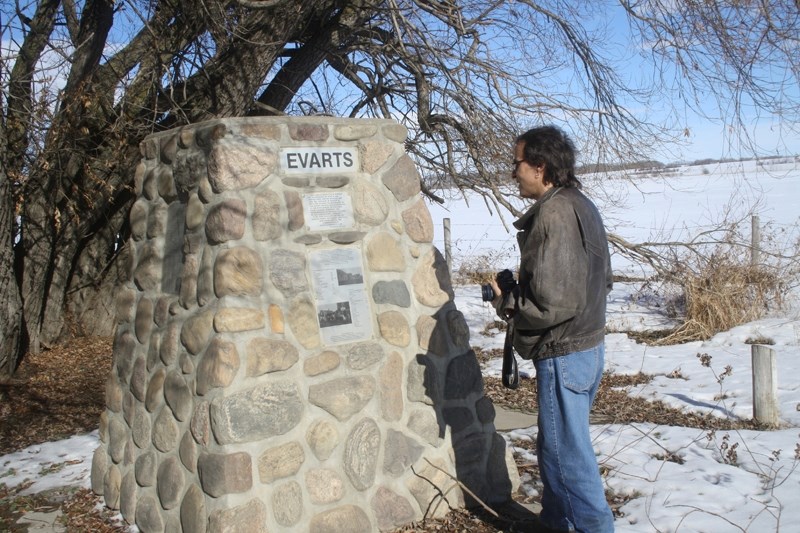Johnnie Bachusky heads out on the winding back roads driving by drilling rigs, electrical stations and scattered farmhouses as the Saturday sun beats down in full force.
The 55-year-old man with the flicker in his eye very much cuts the figure of a part-time historian with his leather jacket, soft cowboy hat and long brown hair.
Today he's on the hunt for clues to lives gone by as the rural chronicler delves deeper into the history of ghost towns in Central Alberta.
“They were prosperous places with a lot of potential and hope,” Bachusky says of abandoned country communities that dot the prairies and foothills. “And now they're just a shadow of themselves.”
Bachusky will be exhibiting photographs from his voyages into the past in a show called Ghosts that runs from March 8 – April 26 at the Mountain View Museum in Olds.
The journey further into the forgotten world of ghost towns is all consuming for Bachusky. He estimates over the past 15 years he has covered over 100,000 kilometres and spent tens of thousands of dollars in his quests, all told.
“I do find it spiritual,” he says. “For me this is how I relax. This is how I remove myself from the everyday trials and worries of life.”
He pours over the map looking for the day's first destination, Stockholm – what used to be a community located just south of Sylvan Lake.
“Oh, this is outstanding,” he says on arrival. “There's the old post office right there. I can get good shots of this old basketball court. Here we go.”
A cream skimming station, a store and a post office had been located near a spring at the turn of the 20th century. Today the church has been preserved but moved. Other buildings are falling into disrepair.
“Sooner or later it will all be gone,” Bachusky says, as he fervently tramps through up to waist-deep snow with his digital SLR nearly glued to his face. “I'm surprised this old post office/general store is still around.”
The crunch of snow sounds crisp in the clear winter air as he positions himself in the bushes for a good angle.
“This is nothing,” he says. “I have hiked dozens of kilometres to get to ghost towns.”
He ties some loose ends together about a historical plaque on its way to Stockholm while chatting with locals before heading to the next stop – Evarts. The town had two restaurants, a hotel, a creamery, two blacksmith shops and more at one time. Now little else remains besides a rock cairn with a diagram displaying former landowners and official information. Tucked away, however, is a real find – a handpainted sign with blue, white and black paint flaking off just down a driveway.
“Evarts COMMUNITY CENTRE” it reads, marking the old building up to which it is nestled. Bachusky is particularly interested in the United Grain Growers logo on the bottom left of the sign.
Donna Erdman, director of the Olds Historical Society, met Bachusky when he came in to the Mountain View Museum while working for the Olds Albertan.
“He really is sensitive to the stories and the people who are involved in the stories,” she says. “He came in to do a story about the museum. All of a sudden it was this idea that we could put a show on.”
Erdman says the Ghosts exhibit is a way to showcase Johnnie's passion for photography and help commemorate the people who paved the way for modern Alberta.
“These are the stories that make our history,” she says. “People say history's boring. Well, it is if you don't look at the stories and look at the people.”
Erdman adds ghost towns existed for a reason at some time, and that's important to remember.
“Something happened that they weren't viable,” she said. “He's looking for reasons why they're no longer there.”
The rest of the day is a spiral further into the echoes of what once was. Instead of a bustling town at the former location of Stauffer, now an oilfield waste facility has appeared. This is all part of the process, Bachusky says. Sometimes things have just disappeared. And sometimes you even get lost.
“It's a sense of adventure,” he says, characterizing the type of treasure hunt he loves. “It's finding old things, pioneer things people have forgotten.”
A quick tour that was at first only supposed to take a couple of hours lasts more than four and a half. But getting caught up in the expedition is half the fun.
The log church and cemetery in Raven is a crowning moment of the day, as the tombstones barely poke their heads out of the snowdrifts. Later, he gazes at the Dickson Store Museum as its administrator pulls up randomly for a bit of casual conversation.
And free-running dogs race by Bachusky's SUV as he winds his way up to Mintlaw.
“I'm driven to find the perfect ghost town shot,” Bachusky says. “There's another one out here somewhere waiting.”
A public unveiling of the display will be made at the museum on March 8 from 7 p.m. to 10 p.m.




